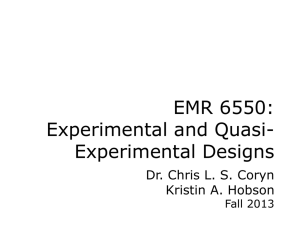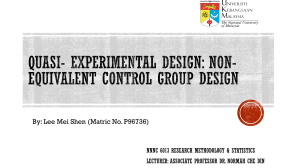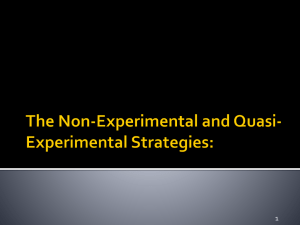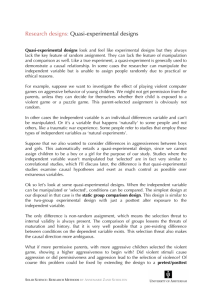Quasi-Experimental Designs That Use Both Control Groups and
advertisement
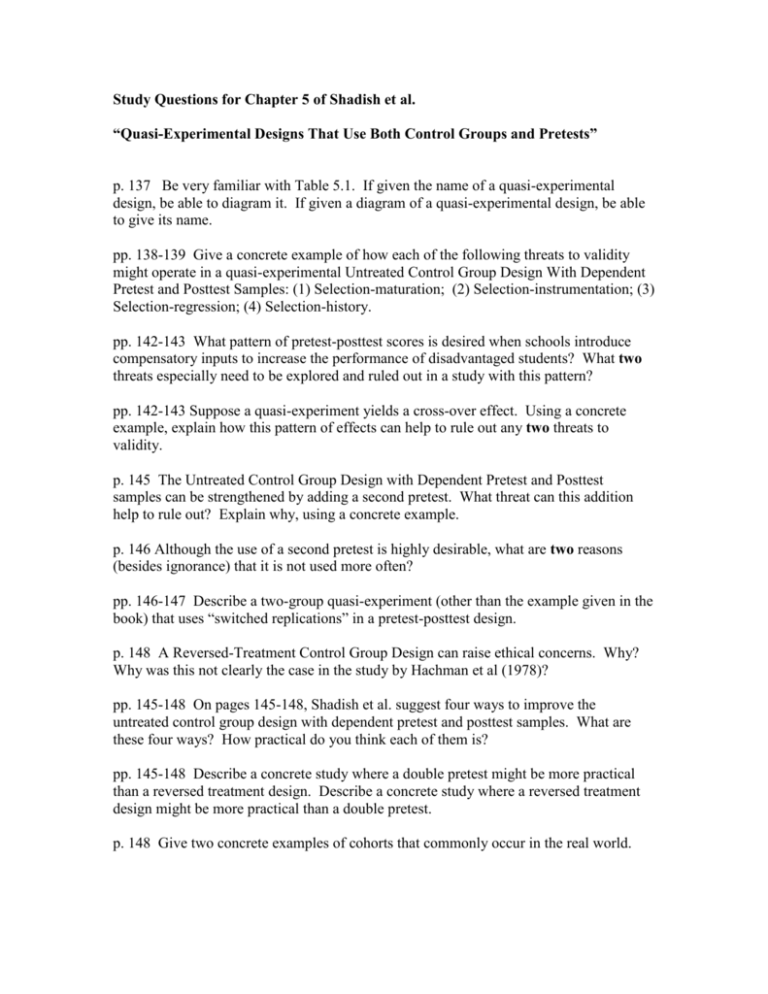
Study Questions for Chapter 5 of Shadish et al. “Quasi-Experimental Designs That Use Both Control Groups and Pretests” p. 137 Be very familiar with Table 5.1. If given the name of a quasi-experimental design, be able to diagram it. If given a diagram of a quasi-experimental design, be able to give its name. pp. 138-139 Give a concrete example of how each of the following threats to validity might operate in a quasi-experimental Untreated Control Group Design With Dependent Pretest and Posttest Samples: (1) Selection-maturation; (2) Selection-instrumentation; (3) Selection-regression; (4) Selection-history. pp. 142-143 What pattern of pretest-posttest scores is desired when schools introduce compensatory inputs to increase the performance of disadvantaged students? What two threats especially need to be explored and ruled out in a study with this pattern? pp. 142-143 Suppose a quasi-experiment yields a cross-over effect. Using a concrete example, explain how this pattern of effects can help to rule out any two threats to validity. p. 145 The Untreated Control Group Design with Dependent Pretest and Posttest samples can be strengthened by adding a second pretest. What threat can this addition help to rule out? Explain why, using a concrete example. p. 146 Although the use of a second pretest is highly desirable, what are two reasons (besides ignorance) that it is not used more often? pp. 146-147 Describe a two-group quasi-experiment (other than the example given in the book) that uses “switched replications” in a pretest-posttest design. p. 148 A Reversed-Treatment Control Group Design can raise ethical concerns. Why? Why was this not clearly the case in the study by Hachman et al (1978)? pp. 145-148 On pages 145-148, Shadish et al. suggest four ways to improve the untreated control group design with dependent pretest and posttest samples. What are these four ways? How practical do you think each of them is? pp. 145-148 Describe a concrete study where a double pretest might be more practical than a reversed treatment design. Describe a concrete study where a reversed treatment design might be more practical than a double pretest. p. 148 Give two concrete examples of cohorts that commonly occur in the real world. p. 149 What research finding has raised doubts about the suitability of siblings as cohort controls? p. 149 Describe Minton’s quasi-experiment to assess the effects of Sesame Street on reading scores. What did she find? Describe specifically how the effects of selection and history may have accounted for the outcomes. p. 151 Describe the example of compensatory rivalry noted by Saretsky (1972). p. 152 Describe a study that uses the “current institutional cycle” design of Campbell and Stanley (1963). p. 153 Shadish et al. describe the Arizona lottery study by Reynolds and West (1987) as an “exemplar of good design”. What was the treatment in this study? What was the (hoped for) effect? How did Reynolds et al. incorporate each of the following design elements: (1) Matching. (2) Multiple pretests and posttest assessments. (3) nonequivalent dependent variables. (4) Repeated treatment. p. 154 How did Gunn et al. (1985) use random assignment within a non-equivalent control group design to study the effects of a health education program? pp. 154 & 155 Both Blackburn et al. (1984) and Farquhar (1990) examined the effects of a community-level intervention to reduce cardiovascular risk factors. (1) Describe the samples and the measurement approach in the independent samples part of these studies. (2) Describe the samples and the measurement approach in the dependent samples part of these studies. What were the two reasons that these researchers wanted to use independent samples? What are the disadvantages of using independent samples (look back to page 117)? What problem developed in the Blackburn study due to the use of independent samples? p. 156 In a study of communities (rather than individuals), what is sometimes an inexpensive way to increase the power of the study? p. 157 What are the four main categories of design elements that can be used to improve experiments and quasi-experiments? pp. 156-157 What assignment method is especially likely to yield different results from studies with random assignment, and therefore should be avoided? p. 158 What is “masking”? Give a concrete example of a study using masking. What are its two main advantages? p. 158 What is the major reason for assessing posttests after a treatment, rather than simultaneously? p. 158 Define and give an example of the special posttest called “nonequivalent dependent variables.” If the treatment is effective, what pattern of results is expected with this design? p. 158 Explain the difference between nonequivalent dependent variables and multiple substantive posttests. Why would a research use nonequivalent dependent variables? Why would a researcher use multiple substantive posttests? From a statistical perspective, what is the problem with multiple substantive posttests? How can this problem be avoided? p. 158 What threats to validity can be examined using a single pretest? Which additional threats can be examined using repeated pretests? p. 159 What is an independent pretest sample? Why might a researcher collect data from such a sample? p. 159 It is particularly important to measure which threat to validity? p. 159 What criteria should be used in selecting a nonequivalent comparison group? p. 159 What is the difference between an internal control group and an external control group? p. 160 What is a secondary data comparison group? What is a normed comparison group? Name and explain the specific threats to validity that make such comparison groups problematic (look back to pages 126-128). p. 160 What is a particularly valuable form of the switching replication method? p. 160 What is another name for the repeated treatments design? p. 161 What two compelling principles were identified by Holland (1989)? Which principle did Holland encourage researchers to emphasize?






